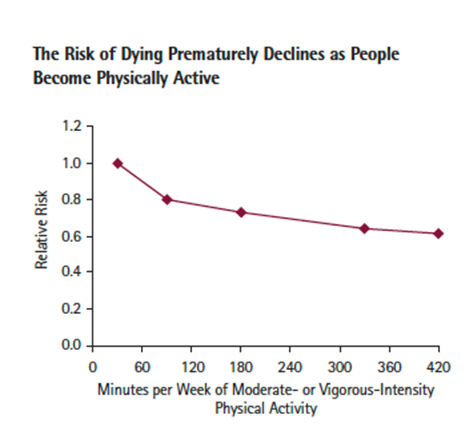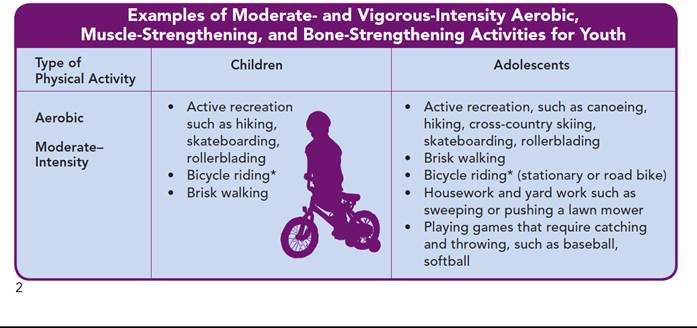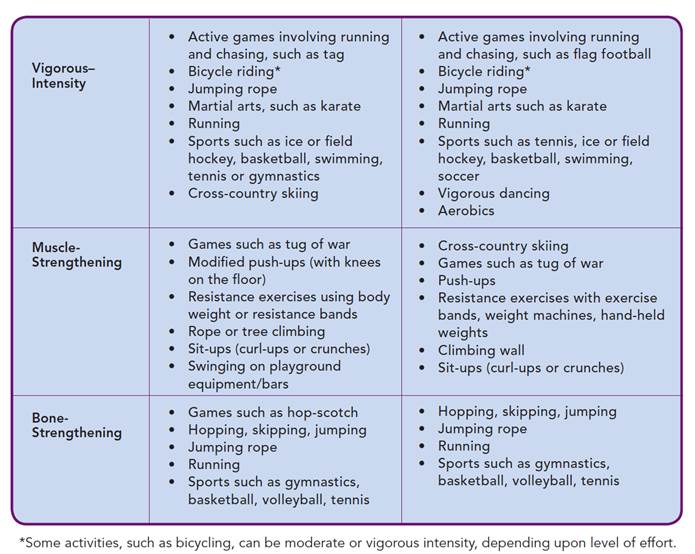 |
|||||||||
Everyone probably thinks that “exercise” is good for them. But most of us are not familiar with the scientific evidence that shows that physical activity provides important health benefits. Of course there are many reasons people engage in physical activity. They include controlling weight; improving personal appearance; improving muscle strength, fitness and athletic ability for participation in sports; feeling better and more energetic; and just having fun at the gym, playing sports or hiking out of doors. And why do we use the term physical activity rather than exercise? Physical activity is muscle contraction that increases energy expenditure above a basal level, the energy expenditures of the human body at rest. Exercise is a subcategory of physical activity that is planned, structured, repetitive, and purposive in the sense that the improvement or maintenance of one or more components of physical fitness is the objective. "Exercise" and "exercise training" frequently are used interchangeably and generally refer to physical activity performed during leisure time with the primary purpose of improving or maintaining physical fitness, physical performance, or health. An excellent source for the scientific evidence of the health benefits of physical activity comes from the U.S. Department of Health and Human Services (DHHS). In 2007, DHHS appointed an external scientific committee called the Physical Activity Guidelines Advisory Committee with the mandate of conducting an extensive analysis of the scientific information on physical activity and health. The committees report, the Physical Activity Guidelines Advisory Committee Report, 2008 formed the basis of the 2008 Physical Activity Guidelines for Americans. Excerpts and summaries from the guidelines and data from additional sources, are presented below. A Physical Activity Report Card for Americans The Health Benefits of Physical Activity—Major Research Findings
The Physical Activity Guidelines Advisory Committee’s review concluded that physically fit and habitually physically active adults are healthier and less likely to die prematurely than those who are sedentary. For those who are sedentary, a midlife increase in physical activity also decreases risk of mortality. Following the Physical Activity Guidelines and getting at least 150 minutes a week (2 hours and 30 minutes) of moderate-intensity aerobic activity will lower blood pressure, improve blood lipids (by increasing the level of high-density lipoprotein cholesterol and reducing serum triglyceride levels ) , lower risk for heart disease, stroke and other cardiovascular diseases, bring about increased glucose tolerance and insulin sensitivity and reduce risk of developing type 2 diabetes, reduce the risk of the metabolic syndrome, improve bone density and reduce risk of osteoporosis, reduce the risk of breast and colon cancer, and prevent or relieve anxiety and depression. The benefits from even a small amount of low-intensity physical activity are striking. People who are physically active for about 7 hours a week have a 40 percent lower risk of dying early than those who are active for less than 30 minutes a week. Even the recommended minimum of 2 hours and 30 minutes (150 minutes) a week of moderate-intensity aerobic activity (e.g. brisk walking) lowers the risk of premature death. One estimate is that as many as 250,000 deaths per year in the United States, approximately 12% of the total, are attributable to a lack of regular physical activity. As is shown in the figure below, the risk of premature death declines with increasing levels of physical activity.
The 2008 Physical Activity Guidelines for Americans list the following health benefits of regular physical activity for children and adolescents and how robust the evidence is for each of the health benefits. Health Benefits Associated With Regular Physical Activity
The following table describes in general terms four levels of physical activity and the consequent benefits.
How much of each of the three main kinds of physical activity (aerobic, muscle-strengthening, and bone-strengthening) is needed for health benefits. Recommendations for balance and flexibility activities are also considered by the Guidelines. Although increased physical activity will contribute getting more physically fit for better performance at sports. The 2008 Guidelines address health benefits, not how to improve performance-related fitness. As little as 60 minutes (1 hour) of physical activity a week seem to provide some health benefits, but research has found that most benefits will accrue for adults from a minimum of 150 minutes (2 hours and 30 minutes) a week of moderate-intensity, or 75 minutes (1 hour and 15 minutes) a week of vigorous-intensity aerobic physical activity, or an equivalent combination of moderate- and vigorous-intensity aerobic activity. Walking is an example of moderate-intensity aerobic activity and jogging or running is an example of vigorous-intensity aerobic activity. For additional and more extensive health benefits, the guidelines recommend that adults should increase their moderate-intensity aerobic physical activity to 300 minutes (5 hours) a week, or 150 minutes a week of vigorous-intensity aerobic physical activity, or an equivalent combination of moderate- and vigorous-intensity activity. The bottom line is that more physical activity confers additional health benefits. Aerobic Activity Aerobic physical activity has three components:
Research has shown that the total amount of physical activity (minutes of moderate-intensity physical activity, for example) is more important for achieving health benefits than is any one component (frequency, intensity, or duration). Anerobic exercise is vigorous exercise, like a 100 yard dash, that causes muscles to go into an oxygen debt. In anerobic exercise, the heart, lungs and blood supply to the muscles cannot keep up with their need for oxygen and the exercise will therefore be of relatively short duration. Muscle-Strengthening Activity Muscle-strengthening activity also has three components:
Bone-Strengthening Activity Key Guidelines for Children and Adolescents Regular physical activity in children and adolescents not only makes them healthier and fit now, but it lowers their risk of chronic diseases and improves their chances of becoming healthy adults. It is important to encourage young people to participate in physical activities that are appropriate for their age, that are enjoyable, and that offer variety. The Guidelines recommend that children and adolescents ages 6 to 17 do 60 minutes (1 hour) or more of physical activity each day. That includes: Aerobic Activity: Most of the 60 or more minutes a day should be either moderate- or vigorous-intensity aerobic physical activity (such as running, dancing, or biking), and include vigorous-intensity physical activity at least 3 days a week Muscle-Strengthening: As part of the 60 or more minutes of daily physical activity, include muscle-strengthening physical activity (such as climbing trees, using playground equipment, or lifting weights) on at least 3 days of the week Bone-Strengthening: As part of the 60 or more minutes of daily physical activity, include bone-strengthening physical activity (such as running or jumping rope) on at least 3 days of the week
Ways to Promote Physical Activity in Youth Beyond Physical Activity for Health: Getting Physically Fit, guidance for Youth and Adults Good research has documented the important health benefits for youth and adults of 150 hours of moderate intensity physical activity a week, and that even greater benefits accrue for 300 hours a week of physical activity. Clearly this level of physical activity contributes to fitness. But what about getting more highly fit with the goal of improving athletic performance? What sort, how often, how intense and what duration should physical conditioning exercises for this purpose be? And what is the best schedule for someone who is sedentary and just embarking on a fitness program? Unfortunately that description fits all too many Americans. Good advice on getting athletically fit is found in the science-based books on aerobics by an exercise physiologist, Dr. Kenneth Cooper, M.D. They provide a practical guide to fitness that was developed by Dr. Cooper for the United States Air Force. He studied the often-poor performance of soldiers at oxygen intensive exercises such as long-distance running, swimming, and bicycling. Dr. Cooper evaluated sustained performance in terms of a person's ability to use oxygen, or aerobic capacity and proposed that the combined capacity of lungs, heart and blood vessels to deliver oxygen to the body was the best index of overall physical fitness. His groundbreaking book, Aerobics , first published in 1968, presented a series of scientifically proven exercise programs to improve physical performance. The training effect brings about biochemical and anatomic bodily changes that improve the body’s ability to use oxygen. Not only do the muscles used in locomotion get stronger, but so does the heart and the muscles used in respiration. Circulation and oxygen transfer is facilitated by lower blood pressure and an increased number of the red blood cells that carry oxygen. Research carried out by Dr. Cooper and other exercise physiologists showed that to get the training effect needed to improve fitness, exercise must be of sufficient intensity, duration and frequency. To help the average person get the exercise needed for a training effect, Dr. Cooper devised a points scale based on the oxygen requirements of a broad variety of aerobic exercises according to their length and duration. For example, walking or running 2 miles in 40 minutes or longer just barely begins to cause a training effect and is awarded one point whereas running the same two mile distance in between 23:59 and 20 minutes gets a point score of seven. To reach what Dr. Cooper considers to be a minimum standard of fitness requires the accumulation of 30 points a week using running, walking, swimming, bicycling or other aerobic exercises in any combination. Dr. Cooper emphasizes that prior to beginning any fitness program or taking a fitness test, it is essential to get a medical check up and clearance, especially if you are over age 30. To help guide initial intensity and speed of progression when starting a fitness program Dr. Cooper has devised exercise schedules based on age and level of fitness based on the fitness tests he has devised, a 12 minute run for distance or a run of 1.5 miles for speed. Dr. Cooper also emphasizes the importance of warming up before exercise and cooling down after. A critical lesson from the experience of many people seeking to improve their fitness is to progress slowly. It is a mistake to rush a conditioning program, a gradual increase in intensity and duration over at least 6 weeks to attain a minimum level of fitness is needed and gradual progression of intensity, duration and frequency over many months thereafter is advisable. For example Jeff Galloway recommends a 30 week schedule as the minimum required for someone to be able to go from an average of running 2 miles a day to be able to finish a marathon. Additional sources of information: More Information on Ways for Youth to Be Physically Active References and Links U.S. Department of Health and Human Services.Centers for Disease Control and Prevention. Physical Activity Guidelines Advisory Committee Report, 2008 http://www.health.gov/PAGuidelines/ U.S. Department of Health and Human Services. Centers for Disease Control and Prevention. 2008 Physical Activity Guidelines for Americans. http://www.health.gov/PAGuidelines/ Harris CD. Centers for Disease Control and Prevention. Morbidity and Mortality Weekly Report, May 2, 2013. http://www.cdc.gov/media/releases/2013/p0502-physical-activity.html Paffenbarger RS, Hyde RT, Wing AL, Hsieh C-C. Physical activity, all-cause mortality, and longevity of college alumni. N Engl J Med. 1986;314:605-613. Paffenbarger RS, Hyde RT, Wing AL, Lee I, Jung DL, Kampert JB. The association of changes in physical-activity level and other lifestyle characteristics with mortality among men. N Engl J Med. 1993;328: 538-545. Blair SN, Kohl HW, Paffenbarger RS, Clark DG, Cooper KH, Gibbons LW. Physical fitness and all-cause mortality. JAMA. 1989;262:2395-2401. Sandvik L, ErikssenJ, Thaulow E, Erikssen G, Mundal R, Rodhal K. Physical fitness as a predictor of mortality among healthy, middle-aged Norweigan men. N Engl J Med. 1993;328:533-537. Hagberg JM. Exercise, fitness, and hypertension. In: Bouchard C, Shephard RJ, Stephens T, Sutton JR, McPherson BD, eds. Exercise, Fitness, and Health. Champaign, Ill: Human Kinetics Publishers; 1990:455-566. Haskell WL. The influence of exercise training on plasma lipids and lipoproteins in health and disease. Acta Med Scand. 1986;711 (suppl): 25-37. Powell KE, Thompson PD, Caspersen CJ, Ford ES. Physical activity and the incidence of coronary heart disease. Annu Rev Public Health. 1987;8:253-287. Leon AS, Connett J, Jacobs DR Jr, Rauramaa R. Leisure-time physical activity levels and risk of coronary heart disease and death: the Multiple Risk Factor Intervention trial. JAMA. 1987;258:2388-2395. Manson JE, Nathan DM, Krolewski AS, Stampfer M J, Willett WC, Hennekens CH. A prospective study of exercise and incidence of diabetes among US male physicians. JAMA. 1992;268:63-67 Cummings SR, Kelsey JL, Nevitt MD, O'Dowd KJ. Epidemiology of osteoporosis and osteoporotic fractures. Epidemiol Rev. 1985;7:178-208 Snow-Harter C, Marcus R. Exercise, bone mineral density, and osteoporosis. Exerc Sport Sci Rev. 1991;19:351-388. Dalsky GP, Stoke KS, Ehsani AA, Slatopolsky E, Lee WC, Birge SJ. Weight-bearing exercise training and lumbar bone mineral content in postmenopausal women. Ann Intern Med. 1988;108:824-828. Lee I, Paffenbarger RS, Hsieh C. Physical activity and risk of developing colorectal cancer among college alumni. J Natl Cancer Inst. 1991;83:1324-1329. King AC, Taylor CB, Haskell WL, DeBusk RF. Influence of regular aerobic exercise on psychological health. Health Psychol. 1989;8:305-324. Taylor CB, Sallis JF, Needle R. The relationship of physical activity and exercise to mental health. Public Health Rep. 1985;100:195-201. Centers for Disease Control and Prevention. Physical Activity and Health. http://www.cdc.gov/physicalactivity/basics/pa-health/ Hahn RA, Teutsch SM, Rothenberg RB, Marks JS. Excess deaths from nine chronic diseases in the United States. JAMA. 1986;264:2654-2659.
|
|
||||||||||||||||||||||||||



